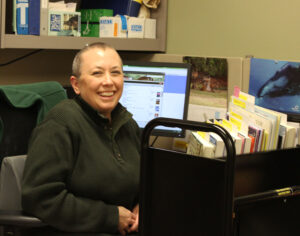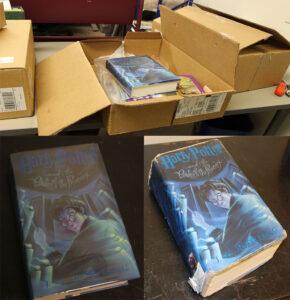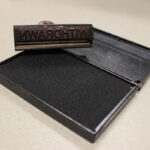Unless you have x-ray vision, you probably never realized there’s a whole library department hidden behind the audiobook wall downstairs. That’s my department, Support Services, and we’re the starting point for every cataloged item in our collection. Books, DVDs, CDs, you name it — they all come through us first. We also handle any repairs to library materials, and when it’s time to remove an item from the collection, we’ll take care of that, too. Basically every major event in the life of a cataloged item involves my department in some way.
To learn about our daily operations, let’s explore the life cycle of a typical library book. The process begins when our erudite librarians send us lists of books to order. (You can suggest a title yourself by completing the form here.) I submit the orders to the vendors, and as I do that, I load the titles into our catalog so that people can see what’s coming. Many of the items have been preordered or backordered, so it may take a while for them to get here, but if you see a title that looks intriguing, feel free to put it on hold! When the books arrive, I scan the ISBN numbers into my computer, which triggers the PROCESSING status in the catalog. I also give each item a library barcode number.

After that, I hand the books over to our cataloging guru, who assembles an informative record for each title. She also assigns everything a call number so that readers know where to find the items on the shelf. (If you understand what all this means, then you can be a cataloger!) Next, our processing virtuosa gives each book a spine label, property stamp, date stamp, RFID tag, and any other necessary pieces of flair, like the occasional duck or unicorn sticker. When the book is fully processed, it’s ready to go out to the public (although sometimes we need to withhold items for a bit to honor publishers’ street dates).

Once a book is circulating, all kinds of things can happen to it. A number of books remain intact for several decades. (I especially love to stumble upon books with the old “West Deerfield Township” property stamp. Those are survivors!) But many books, especially those that circulate non-stop, will suffer torn pages, loose hinges, and cracked spines. When the damage is discovered, those books will make their way back to Support Services. Depending on the severity of the damage, we may be able to repair those books and extend their lifespans. A little glue can make a big difference! However, not everything can be saved. Some books succumb to coffee spills, rainstorms, or acts of dog. Other books just get horribly scruffy from constant use. If a book is in really rough shape, we may need to recycle that copy and order a new one.
 Sadly, some books experience a different sort of problem: they never get checked out at all! In my ideal world, our collection could keep growing indefinitely, but we have limited shelf space, so we must weed our materials on a regular basis. Our librarians will pull the books that need to go, based on circulation statistics and other factors listed in our collection development policy. My department will then remove the items from the catalog and mark them with our big old WITHDRAWN stamps. We give most of our withdrawn books to Discover Books, who will distribute any usable items to schools, community organizations, and other libraries. Other withdrawn books will go directly to local organizations or will be sold in our book sales.
Sadly, some books experience a different sort of problem: they never get checked out at all! In my ideal world, our collection could keep growing indefinitely, but we have limited shelf space, so we must weed our materials on a regular basis. Our librarians will pull the books that need to go, based on circulation statistics and other factors listed in our collection development policy. My department will then remove the items from the catalog and mark them with our big old WITHDRAWN stamps. We give most of our withdrawn books to Discover Books, who will distribute any usable items to schools, community organizations, and other libraries. Other withdrawn books will go directly to local organizations or will be sold in our book sales.
Since we’re constantly adding, repairing, and withdrawing items, we sure keep busy over in Support Services. But I enjoy seeing how our collection changes over time. Unless you’re working behind the scenes, you may not realize just how dynamic our collection is. Many items on the shelf have taken an interesting path to get there, so the next time you borrow a book, take a second to think about where it has been, and where it may go in the future!

